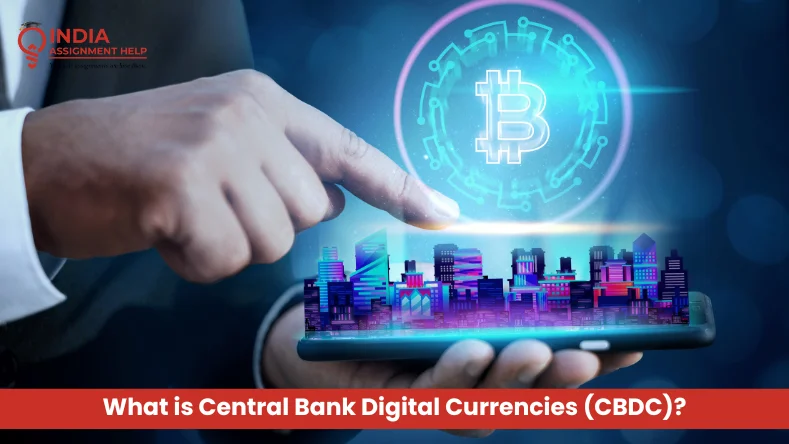Everything You Need To Know About Digital Currency- CBDC & Its Benefits!

The future of money is changing at a pace never seen before. In the realm of technological advancement, several cutting-edge technologies, such as blockchain and cryptography, are changing the landscape of central banking & finance. This is leading to the growing popularity of digital currencies. As a result, central banks worldwide are considering launching their digital currencies, called Central Bank Digital Currencies (CBDCs). According to reports, even the Reserve Bank of India is set to introduce a wholesale CBDC in January 2024. If you are wondering what CBDC is and are confused about whether it is a UPI or a cryptocurrency like Bitcoin, you need not worry anymore. This blog will give you clarity on the topic and its other important aspects.
What is Central Bank Digital Currencies (CBDC)?
Central Bank Digital Currencies, or CBDCs, are digital currencies that are issued by central banks. They are made to make digital payments simpler for both consumers and companies while also offering a safe and practical substitute for hard currency. CBDCs are basically the digital versions of fiat money. Moreover, It is centralized and subject to government regulation. Although the use of CBDC is still in its infancy, some nations are investigating the possible benefits and drawbacks of putting such a system in place. After Australia, China and the US, India announced the launch of trial programs for its own digital currency, the "Digital Rupee."
CBDC enables faster and more secure transactions between banks, organizations, and individuals through a digital ledger that may or may not be a blockchain.
So, It is possible to have different types of CBDCs depending on the technology used, such as CBDC blockchain. Overall, it improves the transaction experience of individuals and businesses.
Difference Between Central Bank Digital Currency (CBDC) and Cryptocurrency
CBDC is often misunderstood as a cryptocurrency, which is not completely true. They are similar, but at the same time there are multiple reasons for which the public digital money is different from the private ones. Let’s explore their major differences.
- While most cryptocurrencies are managed by private organizations or individuals, a country's central bank regulates and keeps track of a CBDC, which is equivalent to the fiat currency of that nation.
- As a digital equivalent of fiat money, CBDC enables users to link their personal information and transactions to their CBDC holdings. The transaction data, however, will only be accessible by the sender, recipient, and bank. It distinguishes central bank cryptocurrency from private cryptocurrencies. As per the information, cryptocurrency transaction details are accessible to the general public. However, private information, including the real names of users, is kept private.
- In contrast to decentralized cryptocurrencies, CBDCs are fully controlled by a bank or other central organization. Opposite to government digital currency, as of right now, the ownership and power of cryptocurrency can reside solely with its users.
- In a short amount of time, the price of bitcoin could fluctuate by hundreds or even thousands of dollars. However, the ideal value of a CBDC would be equal to that of its physical counterpart.
How Indian Central Bank Digital Currency (CBDC) or eRupee is Different from UPI?
With their respective special features and advantages, Digital Rupee and UPI are two crucial foundations assisting India's digital payment revolution. The digital rupee serves as the digital equivalent of the country's currency, which is issued and controlled by the central bank, whereas UPI is a decentralized peer-to-peer payment interface that facilitates real-time transactions between banks. Therefore, it's crucial to comprehend how the Digital Rupee and UPI differ from one another, so explore some of the differences.
- The Indian rupee can be obtained digitally as the "Digital Rupee," which is equivalent to real money in value. However, instantaneous money transfers between bank accounts are made possible by the UPI payment system.
- Government digital currency operates on a regulated infrastructure that guarantees control and security. Whereas UPI operates on a decentralized platform that gives users flexibility and choice.
- Issuing and overseeing central bank cryptocurrency is the province of the RBI. In contrast, UPI, which is used on a decentralized platform with multiple banks and payment service providers, was developed by NPCI.
- All facets of the monetary system, including foreign trade and government benefits, are intended to be digitalized via the Digital Rupee initiative. UPI's primary focus areas are national merchant payments and peer-to-peer payments.
Types of Central Bank Cryptocurrency
Wholesale and retail are the two primary categories of central bank digital currency (CBDCs).
1.Wholesale CBDC
Digital copies of physical currencies are known as wholesale CBDCs. Moreover, financial institutions such as banks are supposed to employ them. Also, interbank settlements and other financial transactions would make use of these CBDCs. The public would not be able to access them.
2. Retail CBDCs
Currency representations in digital form are known as retail CBDCs. The public is the intended user of these. Anyone with a digital wallet could access this government digital currency. They might be used, just like real cash, to make regular transactions.
Merits of Using Indian Central Bank Digital Currency (CBDC) or eRupee
The benefits of digital currency include the following:
1. Faster Payment Method
You may make payments faster when you utilize digital currency rather than more conventional techniques like wire transfers or automated clearing houses. Traditional methods require days for financial institutions to verify a transaction.
2. Cost-effective International Transfer
Transacting internationally can occasionally prove very costly. Transacting money internationally comes with hefty fees for individuals, particularly when converting currencies is involved. Because they make transactions rapid and affordable, digital assets have the potential to disrupt this economy.
3. Financial Inclusion
With the help of CBDCs, individuals who have historically been underserved by the country’s financial system can now access it more widely.
4. Availability
All day, every day, seven days a week, digital currency transactions go at the same speed. However, because banks are closed on weekends and after regular business hours and cannot verify transactions, existing money transfers often take longer.
5. Reduced Manufacturing Costs
There are numerous prerequisites for physical currencies, including the construction of manufacturing facilities. On the other hand, there is no such cost associated with central bank cryptocurrency. Furthermore, unlike real currency, digital currencies are safe from physical damage.
6. Eliminate Risks
Government digital currency minimizes the possibility of other parties being harmed by occurrences like bank runs and failures. It is the central bank's responsibility to manage any remaining systemic risk.
Step-by-Step Guide for First-time Users to Register on eRupee
When it comes to registration in the eRupee app, at times, people get confused. If you want to download the app and sign up for Central Band Digital Currency effortlessly, just follow the easy instructions provided below. If you are among the pre-selected individuals for CUG (Closed User Group) and have been provided with details by your banks on your registered mobile numbers, you can register in the application. Moreover, the information is also provided via email to the registered email address. Search for mail from erupee@sbi.co.in Subsequent to this, proceed further by adhering to these steps.
1. Get the App Compatible to Your Bank
As the first step, you need to find out the specific eRupee app offered by your bank. For example, download the ICICI Digital Rupee app if you have an account with ICICI Bank
2. Configure Your Account
Launch the app, grant permission to access your location, agree to the terms and begin the registration process.
3. Verify the SIM Card you Have
The app will validate your device's SIM card.
4. Protect Your User Account
Use a biometric option, such as FaceID or fingerprint, or set an app PIN.
5. Enter Your Information
To activate your e-Rupee wallet, provide your complete name, link an existing bank account, and create a secure 6-digit PIN.
6. Finish the Verification Process
Enter your bank card's last six numbers as well as the month and year of its expiration. Once done with verification, you have finished setting up your e-Rupee wallet.
7. Load Money
Once you are done with the registration process, funds must be added to the eRupee wallet.
Funds from several UPI applications or the bank account connected to your account can be added to your digital wallet.
After loading money into your wallet, you will be able to conduct transactions in e-rupee.
Procedure to Load and Transfer Money from e Rupee
Make sure that there are enough funds in your wallet before performing any transactions:
1. Get to the 'Load' Option
Click 'Load' from the app menu to add money.
2. Select the Quantity
Enter the desired quantity by typing it in, or choose the value visually by swiping up notes or coins.
3. Choose the Financing Source
To add money, use UPI (note: UPI option will be available later) or your bank account.
4. Verify and Load
Following source selection and amount confirmation, the specified amount will be taken from your bank account and converted to e-Rupee in your digital wallet.
The Process to Transfer Money Using eRupee Wallet
Once your wallet is loaded, send money by following these instructions. However, confirm that the recipient has an operational e-wallet.
1. Begin the Transfer
Choose 'Send' from the app menu.
2. Put the Recipient’s Details
Either manually enter the recipient's phone number or scan their QR code.
3. Give the Amount
You can either enter the desired amount or set it using the 'swipe up' option.
4. Deliver and Verify
For the transfer to be authenticated, click "Send Digital Rupee" and input the PIN from your wallet.
5. Transfer Successfully
The designated amount will be sent from your e-Rupee wallet to the recipients after authentication.
Conclusion
All things considered, this brief manual sheds light on the complexities associated with Central Bank Digital Currency (CBDC). Here, we examined its forms, ways it differs from UPI and cryptocurrencies, and several advantages. Indian CBDC, i.e. ‘Digital Rupee’, comes with increased monetary control, financial inclusion, and efficiency. This completely transforms the way in which money has been used till now, as it is not dependent on any third party and also has minimal risks. Moreover, it increases the confidence of people while making transactions.
Also, it is a very interesting and insightful topic for students who pursue a degree in finance. If you are also studying finance in your higher studies, you might encounter some complicated assignments on this topic. So, in case it happens, and you can’t find the perfect way to write it on your own, you can seek help from us at India Assignment Help. Our academic experts are highly knowledgeable in the field of Finance and can help you improve your grades.
FAQs
Q.1 What Does eRupee look like?
Ans:- The Reserve Bank of India's eRupee is a central bank digital currency that exists solely online. It's a digital currency designed to be used in online transactions that offer a convenient and secure option to cash.
Q.2 How To use eRupee?
Ans:- Users often use digital wallets or certified websites to use eRupee. Within the scope of digital finance, transactions comprise electronic transfers, payments, and acquisitions that enhance convenience and accessibility.
Q.3 How to load Money?
Ans:- Just follow these easy steps to load money in your eRupee wallet.
Step 1: Click "Load" on the app's main page.
Step 2: Enter the desired amount or choose from a variety of denominations by swiping up. Select "Load digital Rupee."
Step 3: Select one of the following methods to add a digital rupee to your wallet, then adhere to the on-screen directions.
- Transferring money from the linked bank account
- Money transfer via various UPI apps
eRupee (Digital Rupee) wallet will be instantly credited with the same amount as the linked account following a successful PIN verification.





